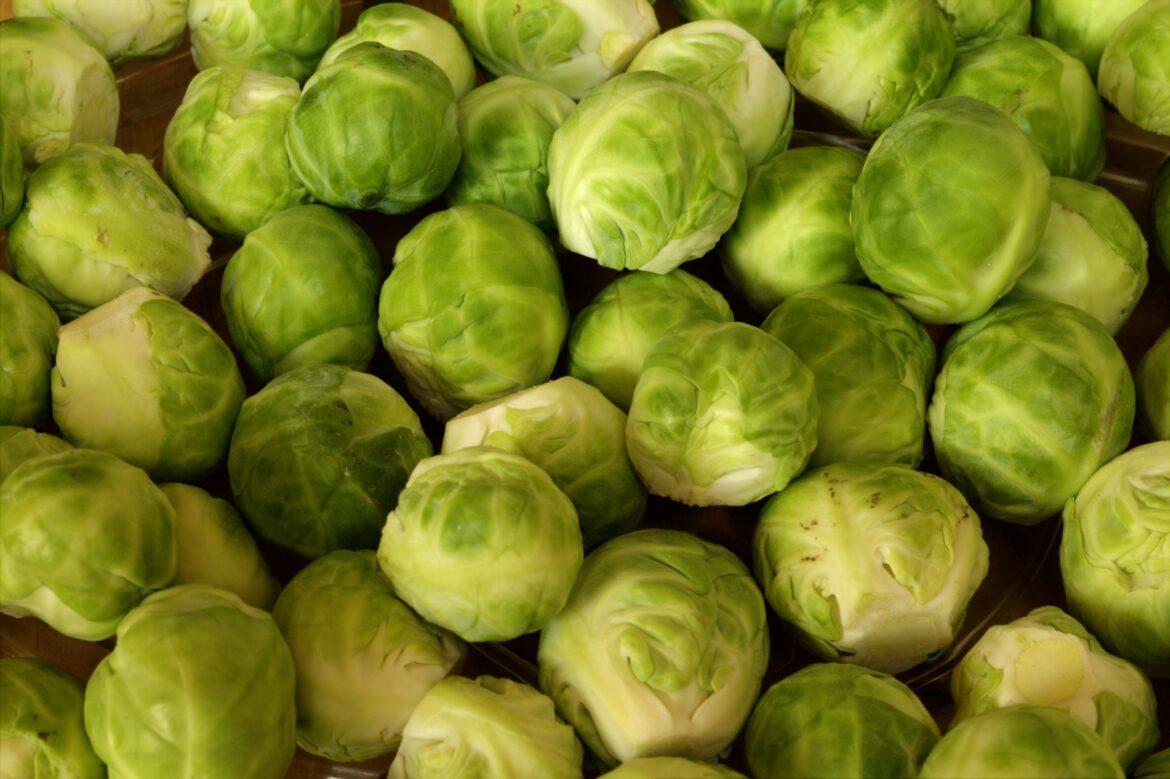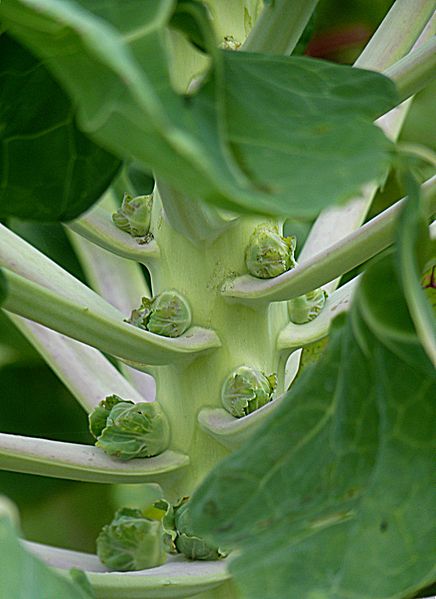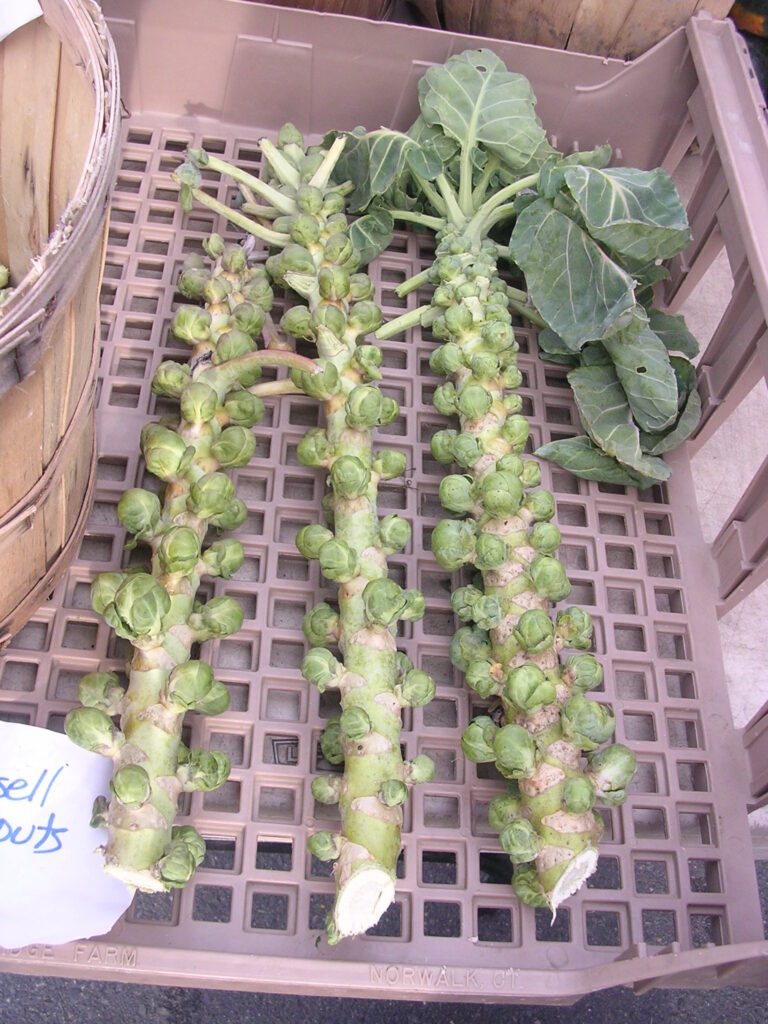Brussel sprout or Brussel sprouts is a common misspelling of this particular vegetable (should be Brussels for both). The name originates from the city of Brussels, Belgium where it has long been popular and may have originated from. Brussels sprouts are an annual cool-season crop, hardy to frosts and light freezes. There are two basic varieties: (1) the dwarf (“Jade Cross”) which matures early and is winter hardy, but more difficult to harvest, and (2) the taller (“Long Island Improved”), which is less hardy but easier to harvest. Brussels sprouts have shallow roots, so as they become top-heavy, you may need to stake them, particularly if exposed to strong winds. As with other brassicas, Brussels Sprouts are susceptible to pests and diseases that must be kept under control early in the season. As with other brassicas, composting roots should be avoided. Brussels Sprouts should not be grown within a 10-foot radius of any brassica growing location within the last 3 years, preferably 7 years. Brussels Sprouts are high in calcium and iron, as well as a good source of vitamins A and C.
Where to grow Brussels Sprouts
Brussels sprouts are a cool-season vegetable, and should not be grown where the summers are long, hot, and dry.
Recommended Varieties of Brussels Sprouts
- Jade Cross
- Long Island Improved
Soil for Brussels Sprouts
Average garden soil enriched with compost and rotted manure, the same type of soil that will support all members of the cabbage family would be a good choice for Brussels Sprouts.
Planting Brussels Sprouts
Germination in 4-10 days.
When –
Start seed indoors in early May so plants are ready to set out in June or early July. The sprouts develop best in cool weather.
How –
In rows 3 feet apart, with 30 inches between the plants.
How Brussels Sprouts Grow
This is one of the strangest looking vegetables. The plant produces tiny little cabbage heads in the axils of the leaves along a strong central stalk. As the sprouts develop the leaves are broken off, so that eventually what appears is a fat, upright stem covered with clusters of sprouts and topped with long green leaves, much like a shortened palm tree. Sprouts develop from the bottom of the plant upward.
| Temperature | |
| Germination | 50 - 80 F |
| For growth | 60 - 65 F |
| Soil and Water | |
| Fertilizer | Heavy feeder; use compost or 2-3 bushels of manure per 100 square feet. |
| Side-dressing | Apply 2 weeks after transplanting, and twice more at monthly intervals |
| pH | 6.0 - 7.5 |
| Water | Average |
| Measurements | |
| Seed Planting Depth | 1/4" |
| Root Depth | 18" - 36" |
| Height | 24 - 48" |
| Width | 24" |
| Space between plants | |
| In Beds | 16 - 18" |
| In Rows | 18 - 24" |
| Space Between Rows | 24 - 40" |
| Average plants per person | 2 - 8 |
| Harvest | |
| For the best sprout growth, when a node begins to bulge, remove the leaf below it. Harvest from the bottom of the stalk up. When sprouts are firm and no more than 1" across, use a sharp knife to cut off the sprouts and remove lower leaves. Leave enough trunk so that new sprouts can grow.As the harvest slows, pinch the top of the plant to direct nutrients to the sprouts. | |
| First Seed Starting Date: | 45 - 80 Days before last frost date |
| Last Seed Starting Date: | 118 - 145 Days before first frost date |
| Companions | |
| Companions | Artichoke, beet, peas, potato, spinach. |
| Incompatibles | Pole beans, strawberry, tomato, kohlrabi. |
Cultivating Brussels Sprouts
Keep weed-free with shallow cultivation or heavy mulching. Grow in the same manner as all cabbage family plants. As soon as the lower sprouts begin to mature, pinch out the growing shoot at the top of each plant (not the entire top leaf). This will stop the top from growing and encourage the sprouts to ripen along the stalk.
| Storage Requirements | ||
|---|---|---|
| Store entire plant in a cool root cellar. Otherwise, leave the stalk in the ground and pick sprouts when ready to eat. Some report harvesting through the snow. | ||
| Preserved | ||
| Method | Taste | Shelf Life |
| Canned | Fair | 12+ months |
| Frozen | Good | 12 months |
| Dried | Poor | |
Harvesting Brussels Sprouts
Brussels Sprouts generally take about 3 months until they are ready to harvest. The sprouts will mature from the bottom up. When sprouts first appear, the lower leaf should be cut off. The sprouts should be picked green when about an inch or so in diameter. To pick them, you can either twist them off, or better yet get a sharp knife and cut them off. Each plant should yield about 1 quart of sprouts. Harvest continues well into the cold fall months. Light snow does not seem to stop their development and even improves their flavor. Harvests of frozen sprouts from plants in January have been reported.
For maximum vitamin C, harvest when the temperature is around freezing. Some say never to harvest unless you’ve had at least two frosts because frost improves the flavor. It has also been reported that sprouts can be harvested through the summer and still be tender if continuously picked when they reach the size of marbles. If you want to harvest all at once instead of continuously, cut or pinch off the stalk top 4-8 weeks before your intended harvest time. After harvest, remove the entire plant from the ground to minimize the chance of disease next season. Some gardeners in severely cold climates may prefer to dig plants still loaded with sprouts and keep them in a cool, light place where they will continue to ripen.
Pests for Brussels Sprouts
- Same for cabbage
- Root Maggot -Place 3-inch tar paper squares around each seedling when transplanting to cover the soil areas; or keep the ground dusted with wood ash.
- Cabbage butterflies/worms -controlling cabbage worms is surprisingly easy. Cover susceptible crops with a floating row cover when planting and leave it in place until harvest.
- Cutworms – Use stiff paper collars around transplants to extend at least 1 inch below the soil line.
- Flea beetles – Dust with wood ash or flour dust.
Diseases for Brussels Sprouts
- Same for cabbage
- Soil fungicides are somewhat effective on Brussels Sprout diseases, but they are expensive, sold in large quantities, and not practical for small home garden use unless a great deal of Brussels Sprouts are grown.
- Clubroot fungus – Most frequent in soggy or acid soil. Grow only in well-drained soil; follow crop rotation practices; lime to keep soil pH at a neutral 7.
- Yellows – A soil-born disease; choose resistant varieties.
- Black rot – Bacteria born on seed; buy only from reputable seed dealers or bedding plant growers; rotate crops.
- Blackleg – Bacteria spreads from infected plants, garden tools, and leftover debris. Follow crop rotation.


